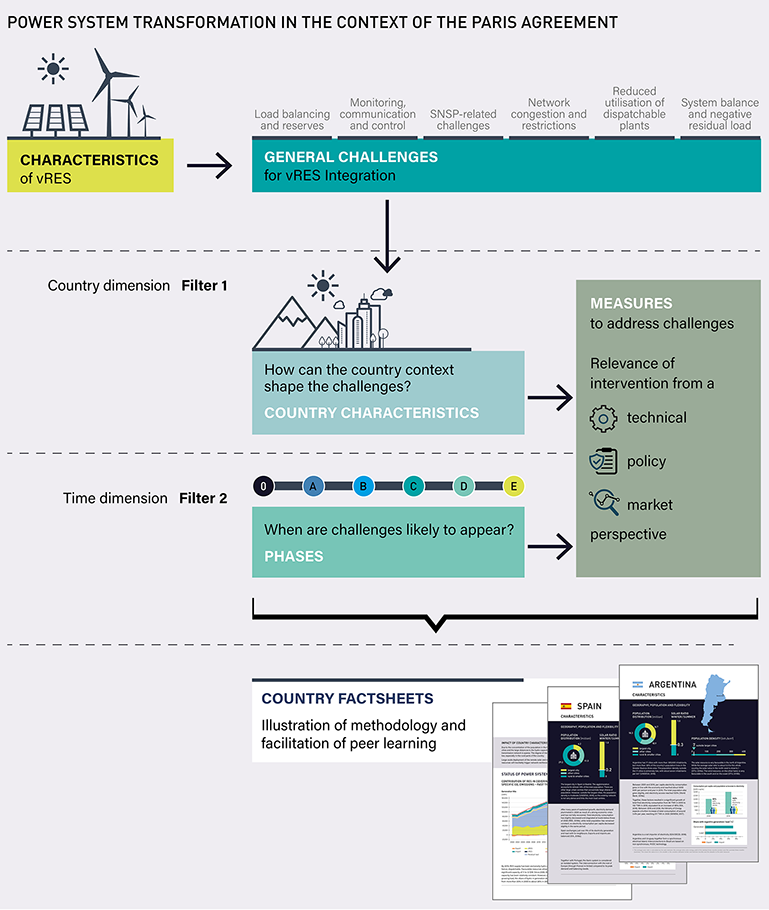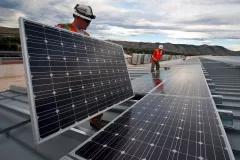This paper develops a qualitative assessment framework that allows policy makers to understand the complexity of power sector transformation and to analyse their country’s position in the transformation process, including key challenges impacting the integration of vRES and examples for technically feasible solutions.
Introduction:
The global energy sector is undergoing a rapid and radical transition in the way energy is produced, distributed and consumed, a shift is motivated by the urgency to ensure secure energy supply, achieve sustainable development and limit climate change. Around two thirds of global greenhouse gases (GHG) and 90% of carbon dioxide (CO2) emissions stem from energy production and use (OECD/IEA, 2018a). Hence, the transition to a cleaner and more efficient energy system is key to achieving the global goal of the Paris Agreement: to limit global temperature rise to well below 2°C, aiming for 1.5°C.
An important step toward a comprehensive transformation of the energy system is decarbonising the power sector. Unabated fossil-based electricity generation must be phased out, and the introduction of low-carbon technologies accelerated. Power systems around the world have already initiated the transformation process, which has been accompanied by rapid cost reductions in power generation technologies (IRENA, 2019). Reflecting this development, the International Energy Agency (IEA) refers to “power system transformation”, describing the creation of a policy and market environment that encourages innovative and sustainable technology solutions for electricity production, distribution and consumption (OECD/IEA, 2018b).
A major concern in the context of power sector transformation is the smooth integration of large amounts of variable renewable energy capacity (i.e. wind and solar) into existing power systems. These variable sources have specific features that differ from those of conventional energy sources, posing fundamental challenges to the operation and governance of a power system. It is important these challenges are recognised and understood in order to identify adequate and timely measures to address them.
The objective of this work is to support a deeper understanding of a country’s position in the power system transformation process, focusing on the technical configuration of its power system, the specific country context and the resulting challenges posed by the integration of variable renewable energy sources. Measures are identified that can help to address and resolve these challenges. At a policy level, more general guidance is provided for policy makers and technical experts in the energy sector on how to facilitate the design and implementation of a smooth transition towards a Pariscompatible power sector.
The structure of this work and how the different aspects that can determine the power system transformation process in a country are related to each other looks as following:
Main findings:
The Paris Agreement delivers a strong message to all countries that elevated efforts are necessary to limit the global temperature increase to 1.5°C. Given the centrality of the energy sector for total global greenhouse gas emissions, the transformation of the energy system is key to achieving the Paris goal.
Power systems around the world have initiated the transformation process as they phase out fossil-fuel based electricity generation and accelerate the introduction of renewable energy technologies. The introduction of variable renewable energy sources (vRES) such as wind and solar at a large scale poses new challenges that need to be acknowledged, understood and overcome in order to facilitate the full decarbonisation of the power sector by mid-century.
This paper develops an assessment framework that allows policy makers to analyse their country’s stage in the power sector transformation process, including the challenges arising in the current and in future stages as well as potential measures to address them.
The measures identified must always be embedded in a regulatory framework that incentivises and supports their implementation. However, given that each country’s regulatory and policy framework is unique and subject to complex political negotiation processes, recommendations may not be universally applicable.
Taking this into account, the analysis undertaken in this paper conveys seven central messages for policy makers:
- Power sector transformation is a process that cannot be implemented overnight but progresses through phases.
- Specific challenges are likely to appear at certain points, i.e. in each phase, independent of a country’s geographic and/ or socio-economic characteristics.
- A country’s geographic and/ or socio-economic characteristics can shape the way in which these challenges influence the integration of variable renewable energy sources. Some characteristics may be favourable, while other may be unfavourable for vRES integration.
- Based on the analysis carried out in this paper, it is possible to anticipate the time of occurrence, plausibility of occurrence and the magnitude of the challenge in different country contexts.
- Measures to address the challenges in different country contexts already exist and are readily available, requiring different levels of action in different areas of intervention, i.e. the technical, policy, and system operation or market design area.
- Measures must be embedded in an effective regulatory framework that supports their implementation. The regulatory framework is country-specific and ideally arises from a careful consideration of several political and socioeconomic factors.
- Key to a successful power sector transformation process is the careful and timely planning of each phase, anticipating the main challenges and identifying appropriate measures and policies for their solution. This ensures the rapid progress from one phase to the next until ultimately achieving full decarbonisation of the power sector.
Although several countries may encounter similar challenges when passing through a certain phase of the power sector transformation process, or when assessing their geographical and socio-economic features, it is difficult to compare countries along these parameters and to derive generally applicable recommendations to guide the power sector transition process. However, the assessment of different countries - and how they have approached certain challenges arising in their country context - can offer inspiration and orientation for policy makers on selective aspects, which they see applies to them. Thus, policy makers can make a choice on the elements of the power sector transformation process where they see room for peerlearning from others’ experiences and those elements where they prefer to go their own way.




